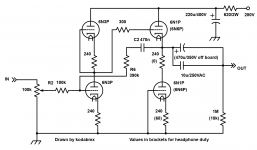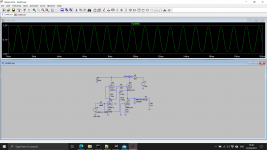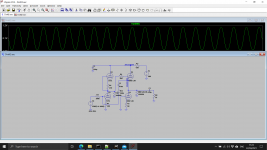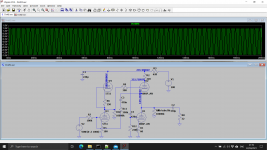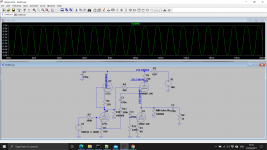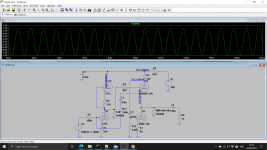I forgot there's an easy fix for that. Since the feedback resistor is 390k ohms (pretty large) you don't need a huge capacitance to pass all audio frequencies of interest from the output to the input tube's grid, while blocking DC. I think 0.47uF will do, but 1uF might be better if you're worried. A 1uF 400V film cap isn't too big of an ask.
I redrew it and I'll give it a try soon.
Attachments
As you can see its not linear for driving 32R phones.
View attachment 944921
I would be adding a say 10:1 transformer on the output to overcome this.
Two questions - was the distortion present at lower levels? Could you change 100R to 68R and see if that helps? How about adding in Rongon's loop as it should lower the Zout?
Thanks!
One of these days, I'll get spice going but since I can't get it running with wine right now, I need to install Windows in a Virtualbox. Then install it and learn how TF to use it 🙂
I get a segmentation fault. There's just not a working package at the moment. The ltspice package actually installs it's own Wine sandbox. The old version worked sort of 🙂
Yup, that's a WCF.
R2 is the (small) plate load on U2.
The inverted signal from the plate of U2 is fed to the grid of U1 through C4.
R12 is the grid leak for U1.
The output is taken from the cathode of U2/plate of U1 (same thing).
New Adventures in the White Cathode Follower
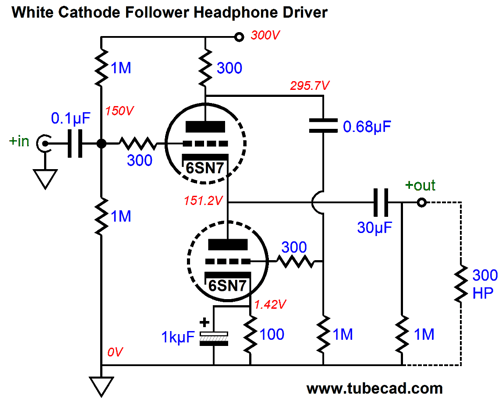
According to theory, the WCF should be able to swing almost 2X its quiescent current, so if you bias the 6N6P to Ip = 20mA, it should be able to swing close to 40mA into its load.
R2 is the (small) plate load on U2.
The inverted signal from the plate of U2 is fed to the grid of U1 through C4.
R12 is the grid leak for U1.
The output is taken from the cathode of U2/plate of U1 (same thing).
New Adventures in the White Cathode Follower

According to theory, the WCF should be able to swing almost 2X its quiescent current, so if you bias the 6N6P to Ip = 20mA, it should be able to swing close to 40mA into its load.
Of course now we have to look at the distortion spectra to see if it's predominantly 3rd harmonic instead of predominantly 2nd harmonic, because now the output stage is push-pull.
Should have been an inventor - never mind. More drive much lower 2nd harmonic, more gain for the NF. Downside is that it can couple HT hum into the output. Does look much better into low impedance.
That's good reading. By tweaking the current sense resistor you can null out the HT hum as the first stage generates some. Just a win win win.
...but only into one specific load impedance. Change the plate load resistor (current sense resistor) value and the null goes away, or... Change the load impedance and the null goes away.
The usual compromise solution is to pick the value of current sense resistor so that the WCF works 'good enough' into the expected range of load impedances; in this case from 32 ohms up to 300 ohms. The target might be 125 or 150 ohms.
That Broskie dude has some wild ideas, eh? That is a good article there. Auto-bias using BJTs....
The usual compromise solution is to pick the value of current sense resistor so that the WCF works 'good enough' into the expected range of load impedances; in this case from 32 ohms up to 300 ohms. The target might be 125 or 150 ohms.
That Broskie dude has some wild ideas, eh? That is a good article there. Auto-bias using BJTs....
- Home
- Amplifiers
- Tubes / Valves
- 6N3/6N6 headphone amp using PCB.
